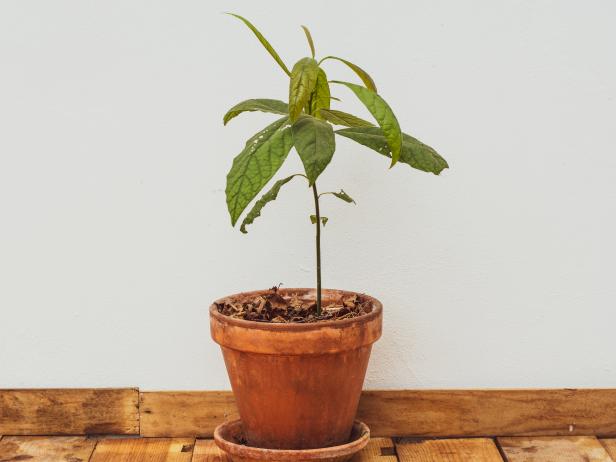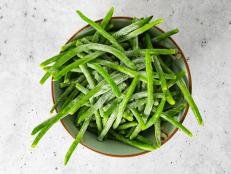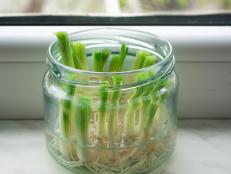How to Grow an Avocado from Seed
Rising avocado prices and shortages be darned. Here’s how to turn an avocado pit into a fruit-bearing tree.

Louise LeGresley/Getty Images
By Layla Khoury-Hanold for Food Network Kitchen
Layla Khoury-Hanold is a contributor at Food Network.
Next time you make guacamole or avocado toast, don’t toss the pit! With a little attention and a lot of patience, you could grow your own avocado tree from seed. Avocado trees do best in warm climates and take anywhere from 5 to 13 years to bear fruit. But it’s a fun project that doesn’t require much gardening experience to start. Here, SJ McShane a plant expert, journalist and small-scale farmer, shares a step-by-step guide for how to grow an avocado from seed.
What to Know Before You Grow
- Hass avocados are the variety typically sold at the grocery store. They will grow 30 feet outdoors; if grown indoors, in pots, the Hass variety will only grow 10 feet. (Other varieties can grow up to 80 feet.)
- Consult the USDA Plant Hardiness Zone Map, which uses average annual minimum winter temperatures to help gardeners determine which plants are most likely to thrive at a location. Avocado trees thrive in warm climates, so when outdoor temperatures consistently reach 50 degrees, plants need to be moved indoors. Indoor temperatures must be warm, 60 degrees and up.
- Avocado trees take 5 to 13 years to bear fruit.
Prep the Avocado Seed
1: Gently wash the avocado pit with warm water.
2: Insert three toothpicks about halfway up the avocado, equally spaced around the seed.
3: Suspend the seed with the toothpicks over a cup or small bowl of water, so that the bottom of the seed (the flat part) is wet. Choose a clear cup or bowl so that you can see and monitor the growth of the root. Cover the seed with roughly an inch of water.
4: Place cup with seed in a sunny, warm spot (around 65 degrees) that receives bright, indirect sunlight.
Avocado Planters
Grow the Roots
5: Once the seed is placed in water, it will take 3 to 6 weeks for roots to develop; be sure to change the water in your cup frequently during this time.
Trim the Roots
6: It will take about 3 months for the roots to reach a length of 6 inches. Once they do, use pruning shears to cut the roots down to 3 inches. Be sure to clean your pruning shears with rubbing alcohol to prevent plant diseases before trimming. Note: You can plant the avocado seed when the roots first hit 6 inches, but cutting them down to 3 inches, and waiting until they grow another 3 inches, encourages a stronger root system.
7: Wait for the roots to grow back to 6 inches in length; at this time, the seed can be transplanted to soil.
Transplant the Seed
8: When the roots have grown thick and reach 6 inches in length, plant the seed with roots facing down in a 10- to 12-inch pot filled with soil, leaving about 1 inch of room at the top. Leave half of the seed exposed and above the soil line.
A note about soil and nutrients:
- Use soil that drains well. Your local garden center or plant nursery will have a good soil potting mix containing everything your seeds/plants need.
- Use a fish fertilizer (fish emulsion) once a month for the first year to supply the growing plant with much-needed enzymes and nutrients. Follow directions on the product packaging for amounts and application instructions.
Repot the Avocado Tree Plant
9: Once established, the plant will grow about 30 inches per year. When the plant gets bigger, you’ll need to transplant the tree to a larger pot. To determine if your plant needs repotting, tip the pot upside down (placing your other hand at the base of the plant so it doesn’t fall out), and gently let the plant come out of the container. Look at the roots; if there are more roots than soil (rootbound) then it’s time to transplant.
Stake Your Avocado Tree
10: Although avocado plants are fast growers, you can wait until they reach a year before you stake. But if you see the plant starting to lean to one side, it’s a sign to stake it. Use a bamboo or wooden stake placed near the trunk and running vertical to it. Then gently tie the stake to the tree using jute, garden twine, a thin rope or zip ties.

Crispin la valiente/Getty Images
Avocado Plant Maintenance
Avocado trees take between 5 to 13 years to bear fruit, so keep these maintenance tips in mind to help ensure a healthy plant.
- Temperature: When the outside temperatures hover around 50 degrees, avocado trees/plants need to be moved indoors. Indoor temperatures should be maintained at 60 degrees or higher.
- Light: Be sure to keep it in a place where there is warm, bright indirect light.
- Humidity: Avocado plants like humidity; place a humidifier near the plant. Humidity is especially important in drier, winter months, particularly if the plant is kept indoors. The lack of humidity in the winter may cause leaves to fall off the tree.
- Moisture: water your avocado plant often so that the soil is moist but not soaking wet, to prevent root rot. Check the soil by sticking your finger two inches down; if it’s dry, then water. Purchasing a plant moisture reader can also help check levels.
- Drainage: Yellowing leaves can mean too much water and not proper drainage; make sure the pot you choose has well-draining soil.
- Air circulation: use a ceiling fan or smaller fan to help create circulation beneficial for plants.
- Pruning: In general, avocado trees to do not need a lot of pruning, but suckers typically appear in early spring. They come from the root system and look like new growth. Simply cut them off with clean gardening shears. If left on the avocado tree, suckers will steal nutrients from the plant and suppress the tree’s fruit growth.
- Pest prevention: Apply organic neem oil on a weekly or monthly basis to help keep pests and plant diseases at bay. The neem oil bottle will have proper application instructions; try using the solution in a spray bottle for even application.
Related Links:


































































